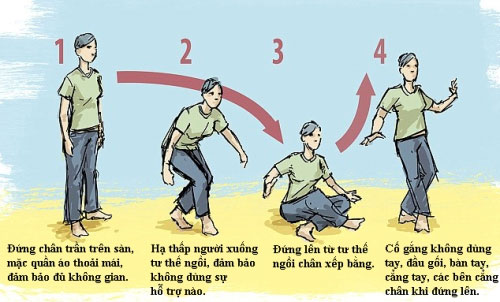Predict your life expectancy through a simple test
With simple sit-ups, the test developed by Brazilian doctors is thought to be able to foretell people aged 51 to 80.
Doing the exercise, each person needs to stand up and sit without using any help. With a maximum score of 10, the operator will be deducted 1 point for each use of the hand or knee to support when standing up and down, minus 0.5 points if staggering balance is lost.
According to the team of doctors, the author of the test, the standing exercise, or the SRT test , measure the patient's flexibility and skeletal muscle strength. The scale system was developed to show that those who only achieved 3 or less points were 5 times more likely to die in the next 6 years than those with more than 8 points.
As a member of the team that developed the capital test originally used to assess the toughness of athletes, Dr. Claudio Gil Araujo, Gama Filho University (Rio de Janeiro, Brazil) currently using this test to convince patients about the importance of movement. This is an indispensable element to maintain the strength of the muscles, helping people to maintain balance and prolong life.
As age increases, the muscles in the body gradually weaken and the ability to balance is also poor. Older people are therefore very easy to lose their balance, leading to falls. This test serves as a way to check for weakness of the musculoskeletal system. It can be applied to the elderly group because of its convenience, can be done at home and does not need any specialized tools to support.

Steps to take the test to predict life expectancy.(Photo: reddit)
The conclusions about SRT testing are drawn from a study of more than 2,000 people aged 51-80 years. At the end of the study, those who achieved less than 8 points increased their risk of death in the next 6 years compared to those with absolute scores. If only 3 points or less is achieved, the probability of dying in the next 6 years is 5 times higher. For one more point, the person performing the reduction reduced the risk of death for himself by 21%.
'Assessment of musculoskeletal health by SRT has many implications in predicting the risk of death, applied to subjects aged 51-80' , the scientists presented in the study published in the Journal of Heart European circuit.
Although admitting the ability to test people's strength and flexibility through a test, UK experts do not think that it provides accuracy in predicting life expectancy due to cultural differences. The British often do not have the habit of sitting on the floor like other countries.
In addition, according to a reputable British physiotherapist, Sammy Margo, the exercise poses a potential risk for people with early symptoms of arthritis. At that time, the knee will be under tension if exercising the movements she describes as 'quite heavy'. The expert recommended not to confirm the quality of the exercise because it is quite simple and not widely used.
British physiotherapists tend to choose another test to reveal life expectancy, during which patients will stand up and sit in a chair and count the number of repetitions in 30 seconds. . According to Ms. Sammy, '30-second check with chairs' is more appropriate and is used as a prognosis for simplicity, quickness, and ease and giving good indicators. The test measures the strength of the legs and endurance, the necessary elements to move without falling. The recommended score for healthy people aged 60 to 64 is 12 times for women and 14 times for men for 30 seconds. The number of points to be achieved for people from 90 to 94 years is 7 times for men and 4 for women.
Note when performing the sit-down test - SRT:
- People with arthritis or those who are worried about injury when doing the movements should not try to test.
- Wear comfortable clothes, no shoes. Make sure the space has enough space to perform.
- Lower the body to the posture of sitting with legs folded, not leaning on anything.
- Stand up without using your hands, knees or forearms, both sides of your legs to push people.
- Ask a grader or perform a gesture in front of a mirror to detect when wobbling or 'cheating'.
- The first part of the test with the sit-down movement has a total score of 5, the rest is a gesture of standing up with 5 remaining points.
- Subtract one point when using your hands or knees to support your body.
- Subtract 0.5 points each time feeling lost balance. Then calculate the minus points to give the final score.
- You will know your life expectancy only thanks to this simple extreme test
- Can accurately predict human life expectancy
- The secret of the relationship between names and life expectancy
- Tests help predict life expectancy from birth
- Death test
- The average life expectancy of Japanese people reaches a new record: More than 87 for women and 81 for men
- A urine test helps predict lung damage
- Artificial intelligence can predict when a patient dies
- Is the life expectancy of human beings reaching the limit?
- Scientists predict human life can reach ... 5000 years
- Whoever has the highest and lowest life expectancy in the world
- The small difference in Japanese life gives them a long life
 Green tea cleans teeth better than mouthwash?
Green tea cleans teeth better than mouthwash? Death kiss: This is why you should not let anyone kiss your baby's lips
Death kiss: This is why you should not let anyone kiss your baby's lips What is salmonellosis?
What is salmonellosis? Caution should be exercised when using aloe vera through eating and drinking
Caution should be exercised when using aloe vera through eating and drinking